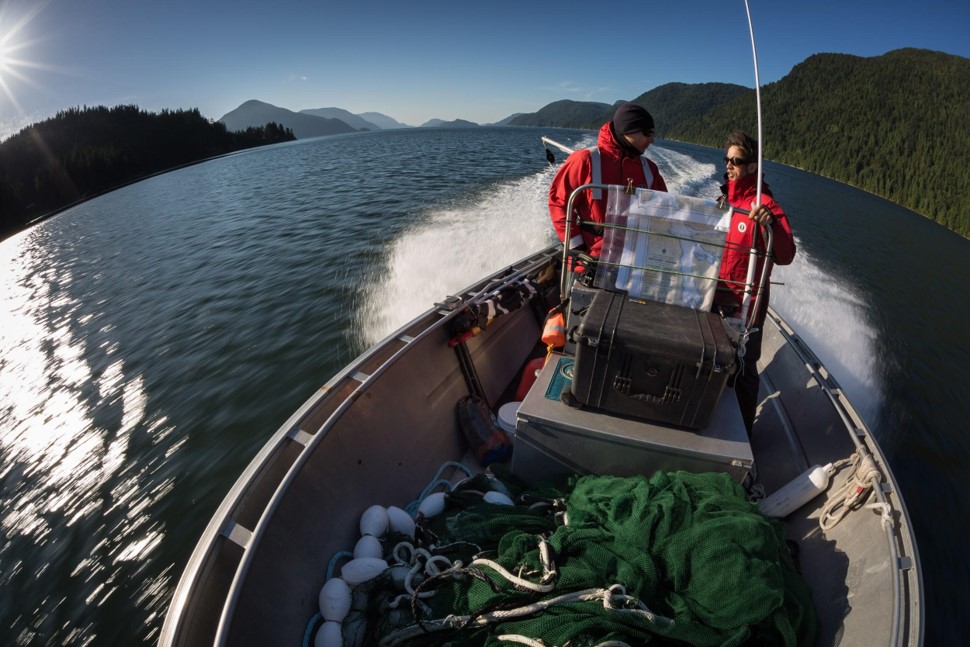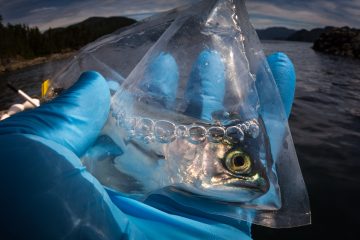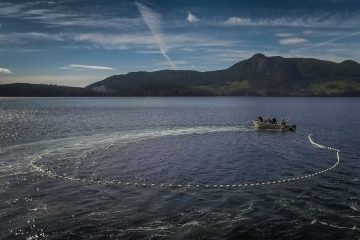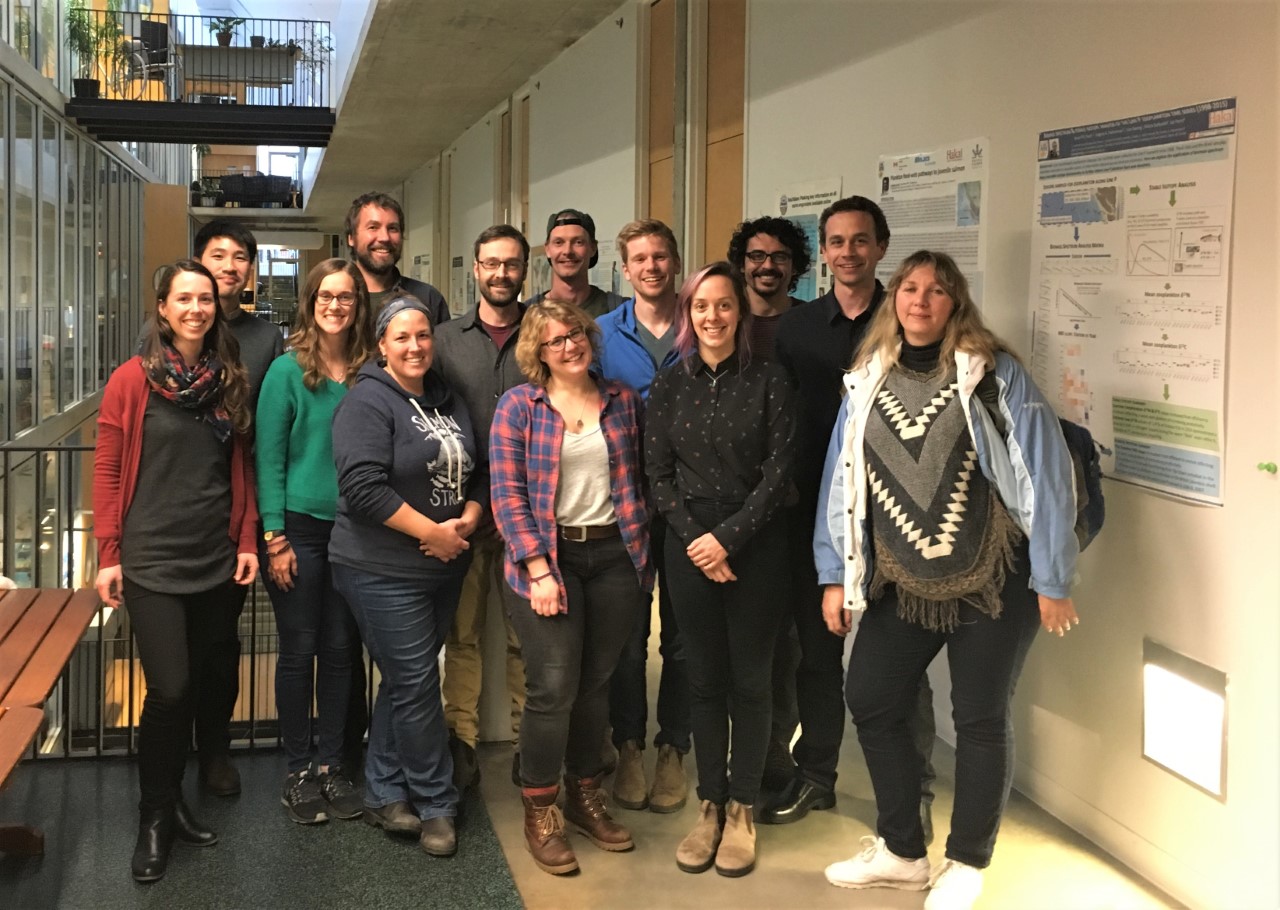Updates from Hakai’s Juvenile Salmon Program

The first months at sea are a critical time for salmon, potentially having significant impacts on stock recruitment. With this in mind, the Hakai Institute’s Juvenile Salmon Program is investigating the factors affecting juvenile salmon across two critical sections of the Fraser River salmons’ northward migration; the Discovery Islands and Johnstone Strait.
The Juvenile Salmon Program was launched in 2015 as a collaboration between two of British Columbia’s coastal research stations, universities, and industry partners. It explores many of the issues facing Pacific salmon, including the physical and chemical conditions, plankton dynamics, salmon feeding, growth, condition, migration, parasites, and mortality. Each of these elements has a whole team of researchers focused on them. On November 9th, UBC’s Institute for the Oceans and Fisheries hosted the Hakai Institute’s 4th annual meeting, bringing those researchers together to report on their findings.
The teams’ recent work has shed new light on water movements through the area, showing that Johnstone Strait and the Discovery Islands are actually two separate water masses divided by a tidal front near the eastern end of Johnstone Strait. As a result, the physical, chemical, and biological properties are unique to each region. This is supported by what was seen in the zooplankton community structure, with different species composition in the northern Strait of Georgia, Discovery Islands, and Johnstone Strait. As a result, juvenile salmon experience an abrupt transition as they transit through each area, with researchers seeing these regional differences reflected in their diets. Across both regions, feeding intensity appears to be low, suggesting that juveniles may be experiencing food-limited growth as they pass through this ‘trophic gauntlet’. Sea lice loads along this route have also been correlated with low foraging success, suggesting that ‘lousy fish make lousy competitors’ and that the sub-lethal effects of sea louse infection on juvenile growth and survival could be more significant than previously thought.
The teams has discovered that the physical, chemical, and biological properties of the Johnstone Strait and the Discovery Islands water masses are unique to each region. As a result, juvenile salmon experience an abrupt transition as they move through each area, with researchers seeing these regional differences reflected in their diets.
RNA:DNA ratios also provide evidence for reduced growth through Johnstone Strait, showing higher fish condition and instantaneous growth rates at the most southern and northern ends of our study area. Otolith microchemistry has also shown that reduced feeding can lead to reduced growth with long-lasting effects. Future work will compare juvenile and adult otoliths to see whether a growth-limited signature on the otoliths from their residence time in this area can be detected.
A more fine-scale analysis of residence time, migration speed, distribution and survival are also being investigated in this complex region through the use of acoustic tagging. Results were presented from the past two years and significant improvements were made in 2018, where 123 of 150 tagged salmon were detected at the receiver sites. Differences were found in the number of salmon, speed of migration, and survival across the multiple Discovery Island routes, providing more insight into salmon movements through this region.
 Salmon Seining at Quadra. |
 Salmon Seining at Johnstone Strait. |
In addition to these research discoveries, the past year has seen some exciting developments for the program, with a new Shiny app created by Brett Johnson (Hakai), interactively displaying recent field data. Program researchers produced many publications and conference presentations, and two team members, Natalie Mahara (MSc, UBC) and Sean Godwin (PhD, SFU), completed their degrees and graduated.
Through the collaboration of all these unique, interdisciplinary projects, the conditions and factors affecting Pacific salmon along this critical migration route are becoming clearer. The team is working hard to fit together more pieces to this oceanographic puzzle, so stay tuned as the bigger picture for salmon in coastal B.C. is revealed.

In attendance were Dr. Eric Peterson, the Hakai Institute’s founder and director (not pictured here), program leads, Hakai staff, post-docs, and graduate students. Left to right: Sam James, Julian Gan, Vanessa Fladmark, Dr. Martin Krkosek, Lauren Portner, Brett Johnson, Dr. Jessica Garzke, Stephen Johnston, Dr. Sean Godwin, Carly Janusson, Dr. David Costalago, Dr. Brian Hunt, and Yuliya Kuzmenko.
Recent North Pacific Anadromous Fish Commission publications describing the program:
- Hunt, B.P.V., B.T. Johnson, S.C. Godwin, M. Krkosek, E.A. Pakhomov, and L. Rogers. 2018. The Hakai Institute Juvenile Salmon Program: early life history drivers of marine survival in sockeye, pink and chum salmon in British Columbia, Canada. NPAFC Doc. 1788. 14 pp.
- Johnson, B.T., J.C.L. Gan, C.V. Janusson, and B.P.V. Hunt. 2018. Juvenile salmon migration dynamics in the Discovery Islands and Johnstone Strait; 2015–2017. NPAFC Doc. 1790. 10 pp.
Written by Samantha James and Vanessa Fladmark
Tags: British Columbia, fieldwork, Hakai Coastal Initiative, Hakai Institute, IOF students, Pelagic Ecosystems Lab, Research, salmon